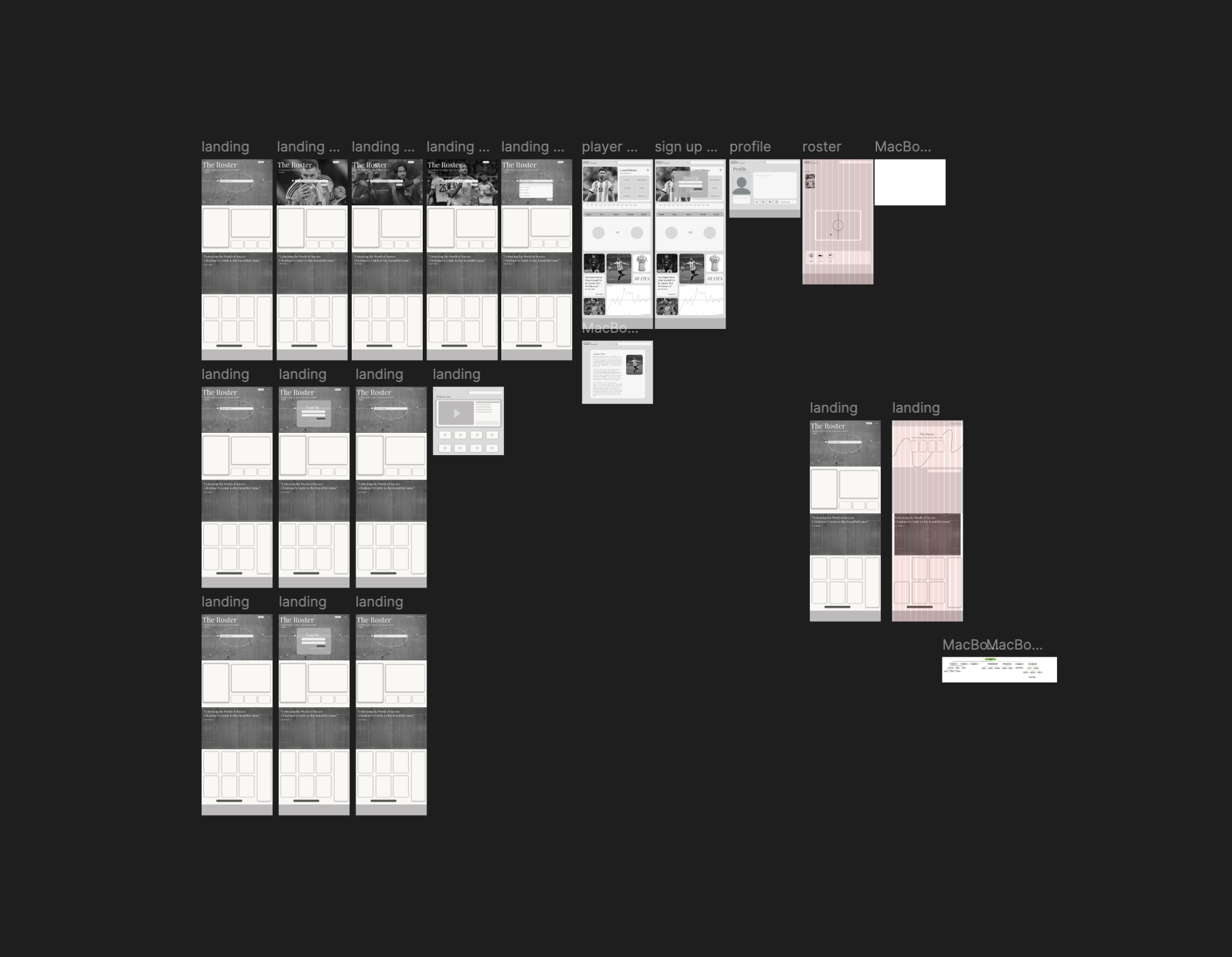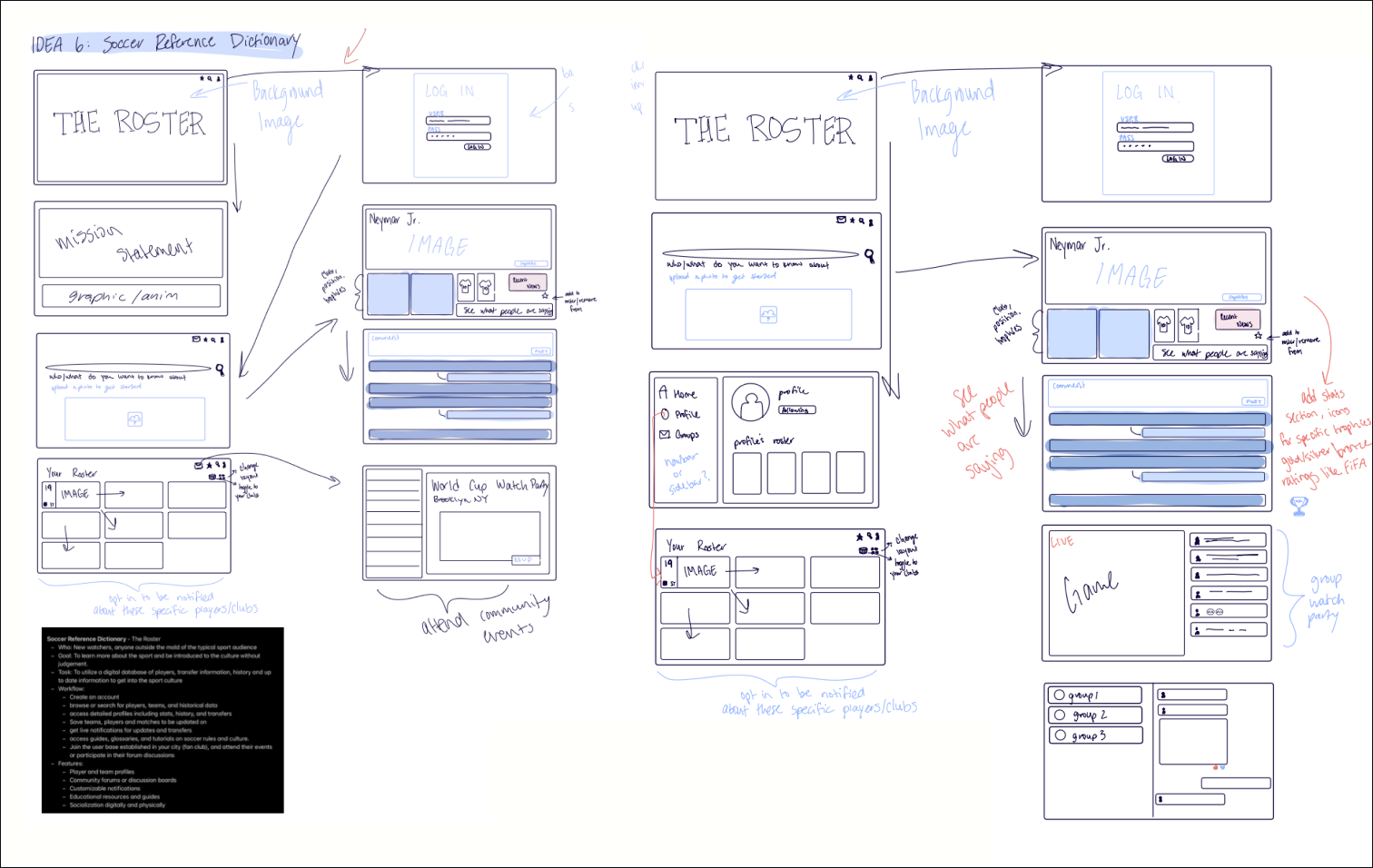
The Roster
Design Case Study 03 / December 2024
The Roster is a comprehensive learning and community-building platform that helps users of all levels understand soccer, stay up to date on teams and players, and foster meaningful connections with like-minded fans.
figma
adobe cc
miro
Personal Project
Designer

The Problem
As a global interest in soccer rises, many new fans are eager to engage with the rich, historic culture but face barriers due to a lack of welcoming communities and accessible guidance. Existing platforms often assume prior knowledge, leaving newcomers overwhelmed by the sport’s complexity and culture. This leads to missed opportunities for both fans seeking connection and the broader soccer ecosystem looking to grow its audience.
The Solution
The Roster is an inclusive platform designed to help new and curious soccer fans learn the game, stay informed on matches and players, and build community. It offers personalized team recommendations, player insights, and real-time discussions, all within a supportive, judgment-free zone. Unlike traditional sports apps, The Roster is built specifically for fans without existing networks, making it easier to feel connected and confident in their soccer journey.
USER RESEARCH
Four interviews were conducted with young women, aged 23-27 and based out of major american cities, who interacted with soccer content for at least 3 hours per week. The interviews followed a semi-structured format with a basic interview script that allowed for deviation based on the interviewee’s responses.
01. Interest began during an International tournament
"I remember watching the [2022 World Cup] final in my apartment and hearing my next door neighbor cheer through the wall"
"I watched the second half at the airport lounge surrounded by strangers huddled around a TV."
All participants mentioned their interest starting due to an international tournament and cited the passion, atmosphere, and the ubiquity of the culture to be part of the appeal.
02. Majority of social interaction online
"It’s always like name five soccer players whenever you’re at a sports bar."
Participants mentioned the constant need to prove that they understand the sport due to gender and nationality, forced to test out multiple physical environments until they found a stable community without that judgement.
03. Ambiguity of choice
"After the World Cup, we started watching the EPL because we thought it would be more fun. I liked [Christian] Pulisic from the World Cup and he ended up playing for Chelsea, so it was kind of a right place right time thing."
Participants struggled to articulate why they support the teams they do. Answers ranged from legacy and nationality to attraction and “vibe.” As U.S.-based fans, they lacked geographic loyalty.
04. Community
"I’ve been watching for 14 years, but it wasn’t until I started posting content on twitter and building a following that I had a real fun community to interact with."
Most participants had been exposed to soccer before, but their passion grew once friends got involved. A shared, understanding friend group made it easier to stay invested.
Key Design Decisions
01. Judgment-free spaces to learn and engage
Participants, especially women, faced constant pressure to demonstrate their understanding of the sport due to gender and nationality biases. The platform should create welcoming, educational-first interfaces that normalize asking questions and learning, avoiding intimidating jargon or assuming baseline knowledge.
02. Emotional connection to team selection
When choosing teams or players to support, participants struggled to articulate clear reasons, often citing intangible factors like 'vibe,' personality, or attractiveness alongside more traditional factors. Recommendation systems should account for subjective, emotional factors beyond statistics—incorporating personality insights, visual content, and community sentiment alongside performance data.
03. Community connection accelerates engagement and retention
Having friends who share soccer interest was stated as making the experience significantly more enjoyable and easier to navigate. Social features should be central to the platform, facilitating friend connections, group discussions, and shared viewing experiences to recreate that supportive community environment.
User Research
Iteration








Feedback & Takeaways
01.
Chat functionality resonates well with users as an engagement feature
02.
Benchmarking analysis provided crisp, actionable takeaways for stakeholders
03.
Beginner user journey could be unclear, need clearer starting point for complete newcomers to soccer
04.
ADA contrast compliance needs attention
05.
Role and value of roster feature must be clarified or highlighted more prominently